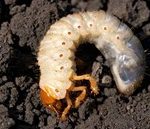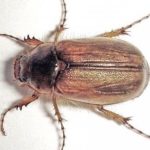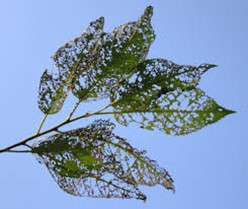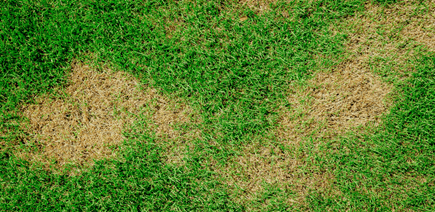| You may only know grass grub as the fat white grub found in your lawn when turning the soil.
Did you know the grub goes into a pupae stage and emerges as the brown beetle? I’m sure you are all familiar with this beetle as a kid, they always appeared in your paddling pool!
Why is Costelytra zealandica a native grub/beetle relevant to trees? This time of year the brown beetles are emerging from the ground in masses, hungry, ready to mate and mobile with wings. During the 3-4 weeks they are active as a beetle, they go through two active phases. When the beetles first emerge, it’s all about mating. Then a busy couple of weeks eating. This is why you see leaves from the Cherry tree with hundreds of holes in the foliage at this time of year. They not only affect Cherry trees but also Blueberry bushes, juvenile foliage and shelter belts trees.
Our customers often ask what is this pest and how do I treat it? This is damage done in a single night of passing from many hungry bronze beetles! The next day they have moved on and not a pest insight, just an unsightly tree that now has a reduced ability to photosynthesize and briefly an open wound that could be point of entry for disease. Good news is that these trees are deciduous so the damaged foliage will fall off during winter, however annual repeated attacks will reduce your trees health and vigour. So how can you identify if you have grass grubs that lead to bronze beetle damage? Have a look around your yard and the lawn, the grubs eat the roots of pasture (lawn) and this presents itself as brown die back dead patches. If you cannot find any in your own lawn, remember they are mobile and not confined by property boundaries so have a look over your fence too, you never know you might be able to help your neighbour out by identifying their lawn pest.
So how can you treat this issue? There are a few options available at your local plant store, we suggest treating the grub first in the lawn before resorting to options of spraying the tree with a systemic pesticide. Systemic pesticide requires a Growsafe license, knowledge, and good timing for this type of treatment. By treating the lawn this will reduce and remove the grubs, improve your lawn quality, and reduce the amount of active brown beetles around home. There are liquid sprays or granules that you apply to the lawn offering a long-term contact insecticides. While this option is effective, there are natural long-term options too. Costelytra zealandica (grass grub/brown beetle) as mentioned is one of our natives and often with natives they have a natural biological control. In New Zealand soil, a native bacterium Serratia entomophila killed grass grubs. However, its only prevalent when there are grass grubs for it to host on. There are companies who supply this bacterium, and it can be affective for up to 5 years in soil! This is our preferred suggestion as it is a natural way of controlling the grass grub/brown beetle. |
- Phone: 03 384 9630
- Email: info@thetreepeople.nz





